by Winding Pathways | Sep 21, 2023 | (Sub)Urban Homesteading, Flowers/Grasses, Foraging, Nature
By September our thoughts and actions turn to autumn – fall sports, raking leaves, and cozy weekend campfires. For wildlife, especially pollinators late summer and early autumn are critical times to gather nourishment for migrations or hunkering down for winter’s scarcity.
-

-
Foraging
-

-
Feeding on nectar.
-

-
Insects find flowers.
-

-
Busy at work.
On our daily walks, often in the early morning to avoid late-season heat, we notice and appreciate late bloomers and nut abundance. Nectar is an important food supply for pollinators who busily forage among flowers. When the weather cools, pollinators are out later in the day as the sun warms the air. Remember, there is a “night shift” of pollinators, too, who need flowers to feed from.
Here are some late-blooming flowers we have seen on walks or that we nurture in our yard.
-
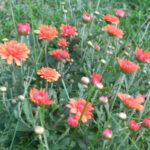
-
cultivated flowers work, too.
-
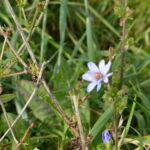
-
Roadside blooms are important.
-

-
Color contrast.
-

-
Some flowers prefer low lying areas to grow.
by Winding Pathways | Sep 7, 2023 | (Sub)Urban Homesteading, Chickens, Garden/Yard
What’s Egg Color Got to Do With It?

An array of jewels. Photo by Lisa Ramlo.
Are brown-shelled eggs better than white-shelled ones? Supermarkets sell all sorts of eggs. Brown or white shell. Free range or not. Organic. Vegan. Prices per dozen vary greatly. How is a consumer supposed to buy the freshest and tastiest egg?
We’ve been raising chickens for decades and have kept hens that lay white, brown, and even blue and green-shelled eggs. All are laid by birds of the very same species. The nutritional value of an egg is the same no matter what its shell color. Taste varies depending on how fresh the egg is and what the hen ate. It is independent of shell color.
Brown Eggs: Most supermarket brown eggs are laid by hybrid hens, often called ISA Browns. These were developed from the somewhat large Rhode Island Red breed. They may be raised in cages in enormous factory farms or come from a smaller free-range flock. Brown-shelled eggs may be free-range or organic……or not.
White Eggs: Almost all supermarket white eggs are laid by White Leghorn hybrids. They are smaller-bodied hens than brown egg layers and are commonly raised in cages in enormous chicken factory farms.
Blue or Green Eggs: Rarely seen in supermarkets, these beautiful eggs are laid by the Araucana breed or hybrids developed from them. These hens are common in backyard flocks.
Organic: If labeled organic the hens are supposed to have been fed feed raised according to organic standards. Eggs marked vegan or natural may or may not be organic. Be wary of vegan eggs, as hens are omnivores. If they encounter insects, worms or meat scraps they’ll readily devour them.
Cage Free: The hens that laid these eggs normally are crammed into a large building but are not confined to the tight space of a cage. They may, or may not, have access to the outdoors.
Free Range: This is tricky. Supposedly free-range hens have ready access to the outdoors, but there may be only a tiny outdoor run for thousands of hens to enjoy.
How To Tell If Eggs Are Fresh

Store-bought eggs are a pale yellow with runny whites. Fresh eggs radiate a golden hue centered in a firm albumen.
Nearly all egg cartons claim that the eggs inside are fresh, but what does that mean? They could have been laid six weeks earlier. To tell if an egg is fresh, fill a deep bowl with water and gently put an egg on the surface. If it sinks it’s reasonably fresh. If it floats it’s old. The reason is, a fresh egg has a small air cell. As it ages, moisture leaves through the porous shell and the air cell grows, making the egg buoyant.
The white, or albumen, of a fresh egg, will be relatively deep when cracked into the frying pan. It will spread out widely and be flat in an old egg.
How to Tell if Hens are Truly Pastured Raised
Most commercial eggs come from hens fed a specially prepared diet that provides all the nutrients they need but little else. The eggs will have pale yolks. In contrast eggs laid by hens with ready access to green vegetation will lay eggs with deep orange or yellow yolks. Some premium chicken feeds include marigold petals that impart deep color to the yolks.
Choosing the Highest Quality Eggs
It may take buying several dozen differently marketed eggs to find the freshest, tastiest, and most attractive eggs. Although the least expensive eggs usually come from factory farms, the best eggs aren’t always the most expensive. The very best will be fresh and have a boldly colored yolk.
For information on chicken breeds scan the Hoover’s Hatchery Website . For general information on eggs and recipes check out the website of the Egg Industry Center.
by Winding Pathways | Aug 24, 2023 | (Sub)Urban Homesteading, Garden/Yard
Curious?

Pods about ready to harvest.
Well, although some websites suggest that, we don’t know. But, now that you are reading, keep on to learn the verified benefits of this unusual fruit eaten most often as a vegetable. One thing is for sure, it LOVES heat!
Okra is delicious.
Eaten raw just off the plant or carried into the house to mix with steamed or sauteed vegetables we enjoy it. A late summer joy is bringing a bowl of okra pods into the kitchen along with tomatoes, string beans, and chard. Too few backyard gardeners grow okra and most people, at least in northern states, rarely eat it.

Botanically, Okra is a fruit.
Okra originated in Africa and loves rich soil and hot weather. It’s a tall plant that produces gorgeous blooms that quickly become slender pods. We pick the pods when they’re just a few inches long and often cut them in sections, dip the pieces in egg and cornmeal and lightly fry them. Yummy.

Mucilage helps make gumbo gumbo!
Okra is high in fiber, folate, antioxidants, Vitamins A and C. The “slime” many associate with okra is actually mucilage which is helpful in digestion. And, it is the “slime” that makes gumbo, gumbo!
Warning
Okra pods grow at an astonishing rate. If we forget to pick them for a few days they grow to six or eight inches long and are woody and inedible. Pick ‘em young and small.
Cookbooks featuring southern cuisine offer many recipes for this vegetable popular south of the Mason-Dixon line but too often ignored up north.
Preserving for the Next Season
Every late summer we let a few pods grow to full size. About the first frost we clip them off, let them thoroughly dry, and remove the seeds for planting next spring.
by Winding Pathways | Aug 17, 2023 | (Sub)Urban Homesteading, Energy Efficiency, Labyrinths, Nature
Coralville’s Unitarian Universalist Society Members
Live What They Profess
In the middle of a worldwide heat wave that scientists declared resulted, in part, from human-caused climate change, we entered the campus of the Greenest Church in Iowa, the Unitarian Universalist Society in Coralville, Iowa. Feeling depressed by climate change news, the visit buoyed our spirits and gave us a glimmer of hope for the future of our planet.
One of the Unitarian Universalists’ principles is respect for the independent web of all existence of which we are a part of. The members of the Coralville church live the principle and others that form their core beliefs.
The Greenest Church in Iowa
As we turned into the Church campus, everything was softer and quieter. We drove past rows of photovoltaic solar cells. Just past them was a world of green. Nestled within native vegetation was a lovely contemplative labyrinth. A vegetated detention basin is both the home for pollinating insects and a place to catch stormwater, preventing it from scouring its way downhill.
We walked a delightful path circling the organization’s eight acres. Native flowers were alive with pollinators, and a children’s play area was meshed into nature. It’s almost as if this location were meant to be.
-
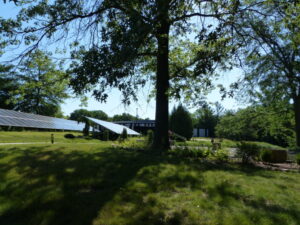
-
south facing solar panels
-
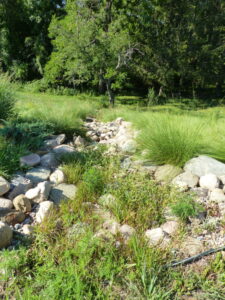
-
Water slows down as it percolates through the bioswale.
-
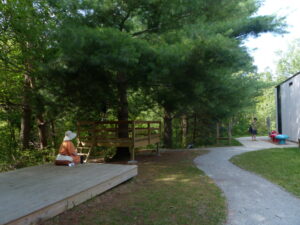
-
Families outside
On entering the building, the Church’s low ceiling entry opens into expansive spaces, an echo of Frank Lloyd Wright’s style. An immediate sense of calm and comfort enveloped us. Just beyond the cozy foyer, our eyes were drawn upward. East-facing windows framed an Iowa summer sky dotted with puffy clouds. Outside, deep green pines swayed in a gentle breeze. Members greeted us and Sally Hartman, chair of the Social Justice team, hosted us during the service. Worship leaders were engaging, the acoustics excellent, and the presence of the outdoors through the windows soothed us.
-

-
A lovely, open space
-

-
Visuals and audio enhanced the service.
-

-
Living the mission
How Did This Come to Be?
Depending on one’s perspective, this church and location have been in the making since the 1990s. More recently since 2013. Sally, also a member of the Iowa UU Witness Advocacy Network, and Kirk Witzberger, who served on leadership teams that developed and implemented the plans, explained. Over many decades, the Society recognized that even with renovations, the former Gilbert St. site in downtown Iowa City could not meet 21st Century needs. Different teams looked for new property. After an almost certain deal for another property fell through, a member happened to chat with a realtor who mentioned the current site. The Congregation voted overwhelmingly to buy and the couple who owned the land, former Peace Corps volunteers, were delighted to sell to an organization that respected the land.
Multiple meetings and myriad decisions followed. The result is a beautiful net zero building that the congregation shares with the community. The building burns no fossil fuel. Solar energy produces all its energy needs, including lighting, heating, and cooling.
Efficient and Flexible
The building includes a sanctuary, gathering spaces, offices, classrooms, and food service areas. Tucked into the property, it fits well. As attractive as its outdoor vegetation is, the building was well thought out. Just a few examples include:
- Efficient glass walls boost energy efficiency while allowing people inside to feel like they’re sitting in nature. We enjoyed watching clouds drift by during the service we attended.
- Flexible space can accommodate large groups of up to 600 or be compartmentalized into smaller, more intimate gathering places.
- All areas are easily accessible for folks with walking challenges. Even carpets are precisely flush with adjoining harder floors.
When we asked Kirk Witzberger, who was instrumental in the transition to this location, what the utility bill is he said, “We don’t have one. This is a zero net energy building…..it produces all its energy needs.” For members of an organization to live as lightly on the land as possible is impressive!
-
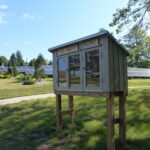
-
Free food and books.
-

-
Soft lighting directs footsteps.
-

-
Efficient east-facing windows let in light and bring a sense of nature inside.
-
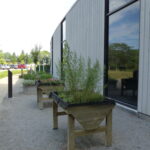
-
Greenery softens the outside scape.
Living Other Principles
The Coralville Unitarian Universalist Society members live their commitments in other ways, too. Members take turns recycling compostable materials. When outside groups rent the space, they agree to a contract of sustainability – i.e. use only recyclable materials. The church is investigating how to be a “cool” refuge in summer and a “warm” refuge in winter. Further, members are researching ways they can offer a safe learning space for marginalized youth with activities like art and music. Members have held summer Nature Camps and environmentally-themed Trunk and Treats, and sponsored an environmental fair designed to raise awareness and action in caring for our world.
Inspiring Model
After touring the building and grounds we wondered why the model of the Unitarian Universalist Society isn’t more common in society. It should be. If people associated with all buildings everywhere did what they could to produce their energy needs through renewable sources the threat of climate change would be muted and our children could look forward to a cleaner and safer world.
Want to visit? The Church welcomes you. Details are on their website.
by Winding Pathways | Jun 22, 2023 | (Sub)Urban Homesteading, Foraging, Mammals, Nature, Pests
Fish Camp Woes
This year a giant bear tore up the Popsie Fish Company’s camp near the remote Egegik River in Southwest Alaska before the salmon arrived. These huge brown bears are smart, hungry, and massively powerful.
Early Work on Salmon

Good Catch
Early in his career, Rich was a salmon biologist for the Alaska Department of Fish and Game, working near the Egegik River. While there he loved eating the most delicious fish……. Sockeye Salmon.
During the summer millions of wild salmon of five species swarm into Bristol Bay but the sockeye is the most abundant. They are caught by many commercial fishing companies who net them in the bay and along beaches. State biologists ensure that enough fish survive nets to ascend rivers, spawn, and produce plenty of young to keep the runs robust.
Remembering Salmon Dinners

Fresh salmon is a treat.
Nearly a half-century ago he and Marion, co-owners of Winding Pathways, moved to the Midwest where there are no Sockeye Salmon. But they love grilling salmon fillets they order from the Popsie Fish Company. It catches, processes, and ships frozen fillets. The Pattersons occasionally order a box. In addition to being delicious and healthy, Alaskan Sockeye salmon are wild fish managed as a sustainable resource.
Bears on the Prowl
This year Popsie Owner Tony Neal had a problem. Like all commercial fishermen, he and his staff arrived well before the salmon run to set up their camp and prepare for fishing. That’s when the trouble arrived.
A brown bear tore its way into their building. Take a look at the photos to see what the bear did. It’s a mess.
-
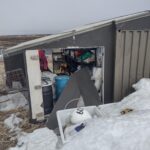
-
Bears are powerful. Photo Eric Handstad
-

-
The work room is all shambles after a bear tore it up. Photo Eric Handstad
There is good news. There’s enough time before the salmon arrive to get everything fixed and ready to catch those delicious fish. To see Popsie Fish Company staff in action take a look at their website www.popsiefishco.com.
Increasing Occurrences of Bears
Iowans occasionally report a bear sighting, especially in NE Iowa where the woods make great shelter and rivers excellent corridors to travel.
Bears are increasing across the country even in urban areas. Past photos in papers have shown a bear walking down a major road near New York City. A recent newspaper article reported how a bear crashed into an Avon, CT, bakery and gobbled up 60 cupcakes before lumbering off. At Cedar Lake, Denville, NJ, a mama bear, and three cubs were recently spotted walking along the road. Actually, that is a fairly common sighting. Residents spread the word so walkers will be alert.
-

-
Suburban NJ has some prolific and big bears.
-
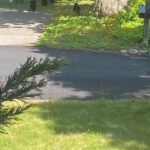
-
Bear and cubs. Photo Catherine Christ
The town police even fondly named one bruin “The Italian Bear.” Each night just after restaurants closed a fat bear would wander from its den, climb into the local Italian eatery’s dumpster, gorge itself, take a snooze, and come morning, climb out and go back to its secret den. Never hurt anyone.

SRF took this pix of a bear peering in the window.
In rural New Hampshire, friends have had bears visit the yard and peek into the house through the windows frequently.
First Person Story

Picket fence was torn apart by a hungry spring-time bear.
Jackie and Peter Hull in Bedford, Virginia, shared this first-person story of the spring adventures with an unruly bear. “Well, I got up bright and early one spring morning, peeked out the bedroom window and what did I see? A smashed six-foot piece of picket fence, a broken spindle on the front porch, and a shepherd’s hook bent to the ground.
“Lucky me I brought the bird feeders in last night. So now I know I can’t feed the birds anymore this year. This is the second year running when on Mother’s Day last year, a bear came and smashed the spindles on the porch railing and a different six-foot piece of fence.
“Later we found bear tracks in the red Virginia clay bordering the flower bed on the outside of the fence. It left its muddy red prints on the fence and the steps going to the side door of the house!
“What to do but repair the fence again, wash the feeders, and put them in the basement? I have decided to store the leftover bird feed in a large bag in the freezer for next winter.
“I will miss my “bird buddies” but I don’t what a 250+ pound bear in my house either. So, words to the wise, the same ones the ranger gave me last year, ‘Bring your feeders in now.'”

Alaskan Bear.
Back in Alaska, it is common even in suburban Anchorage neighborhoods to see a bear lumbering down a road. An Alaska-born, former Gazette editor spoke nonchalantly about bears and recess at schools. “We always had outdoor recess…except when a bear roamed the playground.”
Bears are about that is for sure!
by Winding Pathways | Jun 8, 2023 | Garden/Yard, Nature, Pests
A “Hard Knock Life”
A tick’s life is hard. I’m hungry. I am a tick and I’ve been waiting a week for a juicy raccoon, dog, or wild turkey to walk by. Even a mouse would be welcome.
So far, no luck. I know a tick’s best bet for grabbing a passing animal is the “questing” position, so I’ve been hanging on to a branch with both pairs of my hind legs. My front pair of legs sticks out into the path ready to grab the fur or feathers of a passing animal. So far, no animal. Patience is hard and I’m hungry.
Larval Luck
I was luckier last year when I was a larva. I was hungry then, too, but the wait was short. A big, furry animal humans call a dog ambled by. Even though I only had six legs then I was able to grab a hold, and the rest was easy. I crawled around exploring under the fur until I found a spot with soft thin skin, dug in, and chowed down. Boy was that blood tasty! It was so nutritious that I left my host to grow and graduate. I’m now a tick nymph, complete with eight legs, but I need more blood to transform into an adult.
I’m still hungry. As I sit waiting, I admire the mosquitoes and flies that buzz by over my perch. They don’t need to be patient but can fly and search for a blood-rich victim. I can’t fly or jump, so all I can do is patiently wait until something walks by. I hope that’s soon because many of my fellow ticks starve.
Attracted to Carbon Dioxide and Moisture
What’s this? I sense a bubble of carbon dioxide and moisture. Might be the breath of an animal. Now I feel the vibration of footsteps. Must be a big animal. My front legs are outstretched in anticipation and I’m not disappointed.
I grab hold of a strange animal. It’s tall with only two legs. No hair. No feathers. Just some sort of covering over thin skin. No chance of biting through it, but I got a good grip on that covering and started climbing using all of my eight legs. Soon I was under what humans call pants and kept exploring and climbing. Bingo, I found a nice moist spot where my blood dinner was just beneath thin skin. I got ready to feast.
Then something happened. I should be happy with a meal so close at hand. Instead, I felt sick. My legs wouldn’t hold on and I dropped to the ground lifeless.
About Ticks
Pity the poor tick the above. Well, maybe not. It’s hard to pity an animal that can spread disease and discomfort. Ticks usually feed on mammals, birds, and even reptiles but if none come around, human blood suits them just fine.
Ticks are effective disease spreaders because of their relatively long life which can extend for two or three years and their habit of eating a blood meal during different life stages. This enables them to bite one animal carrying a disease in its blood and inject it into a different animal during a later feeding.
Seriously Avoiding Ticks
At Winding Pathways, we take ticks seriously. Rich has had Lyme disease twice, fortunately successfully cured by strong antibiotics. Other people are not as lucky and experience long-term symptoms. And, Lyme is not the only disease ticks spread.
Understanding ticks and taking precautions reduces the odds a person will be bitten and contract a disease from them.
How ticks Operate
Ticks are ambush hunters. As the tick describes above, they wait for a victim to pass within grabbing distance of their front legs. Often ticks walk around on their victim for several hours before they dig through the skin and help themselves to a blood meal.
In order to contract a tick-borne disease a victim must be bitten, so a walking tick won’t transmit illness.
Reduce Your Odds
We often explore the woods, work in our yard and garden, and generally spend time in tick country. Here are precautions we take that reduce the odds of a tick bite:
- We spray our outdoor clothes and shoes with permethrin. It lasts for several washings and kills ticks. The hapless tick described above fell victim to this chemical.
- We often tuck our pants legs into our socks, sprayed with permethrin, to make it hard for any tick that gets on our socks or pants to get under them.
- After returning to the house, we disrobe and shower after we have checked for ticks. They prefer moist dark body areas so we especially check those places. Clothing goes into the washer.
- We watch for symptoms of Lyme Disease, especially a rash and fatigue. If they appear we call our physician immediately.
Promising Product
A few years ago, Rich was so determined to prevent another Lyme Disease incident that he invested in socks, pants, and shirts from Insect Shield. The company infuses its clothing with permethrin that, they claim, is effective for at least 70 washings.
Does this chemical work? Is Insect Shield clothing worth buying? Well, since wearing it Rich hasn’t found a tick on him and he’s been free of Lyme Disease. That’s not a scientific verdict but it’s good enough for him to keep wearing the clothes.
-

-
Tiny ticks can cause problems, so we go prepared in nature.
-

-
Pants, boots, varied sprays can reduce odds of picking up ticks
-
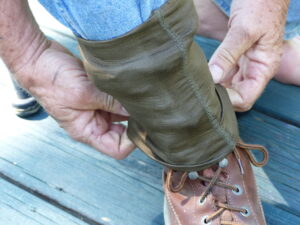
-
gaiters with tick guard helps repel ticks.
-

-
Pants, shirts, and socks infused with permethrin appear to keep ticks off.
Disclaimer
Rich purchased his Insect Shield clothing at the retail price. He’s still testing them but they seem to work. Winding Pathways was not paid for this blog.




































